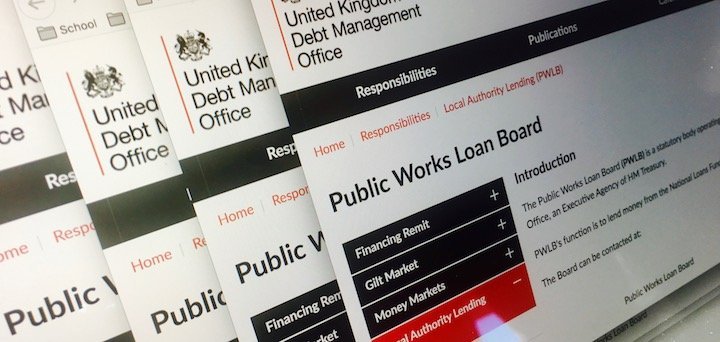
Whitehall today threw a hand grenade into local authority borrowing plans by announcing a whole percentage point increase in the rate of borrowing from the Public Works Loan Board (PWLB).
Borrowing from the loan facility has continued to increase at a rapid rate in recent years due to record low rates on offer – with many using the money to invest in commercial property to produce a financial return to invest in services.
SAVE THE DATE – LATIF NORTH
March 25th, 2020, Manchester
Council treasury investment & borrowing
In a letter to chief finance officers at local authorities sent on Wednesday, the Treasury’s local government and reform team called a brutal halt to that spree with the rise, which takes immediate effect.
The move increased the rate for a PWLB 50-year new maturity loan from 1.81% to 2.82% overnight.
The letter said: “Some local authorities have substantially increased their use of the PWLB in recent months, as the cost of borrowing has fallen to record lows.
“HM Treasury is therefore restoring interest rates to levels available in 2018, by increasing the margin that applies to new loans from the PWLB by 100bps (one percentage point) on top of usual lending terms.”
The statement said the government will monitor the impact of the change and keep its rates policy under review.
It added: “As always, the government will continue to work with individual authorities on a case-by-case basis if they have concerns over their financial position.”
Reacting to this week’s announcement, David Green, client director at treasury adviser Arlingclose, said: “This effectively prices the PWLB out of the local authority loan market.
“There are plenty of other lenders out there, including banks, pension funds and other local authorities, willing to lend at cheaper rates.
“For larger projects it also makes issuing a bond more cost effective. But borrowing authorities should be prepared for more paperwork and longer lead times to secure the cheaper finance.”
Richard Harbord, former chief executive of Boston Borough Council, told Room 151: “This will have a dampening effect on councils refinancing their debt. With Brexit looming, many in the sector will be worried if this is the start of things beginning to go pear-shaped.”
He said that the rise in rates could scupper capital infrastructure projects being planned by councils.
“A lot of local authorities financing is marginal and this big rise could tip schemes over the edge of unviability.”
Mike Jensen, director of investment at Lancashire County Council, said: “I have been forecasting such a move all year so I am not surprised.
“But I am shocked how much they have moved the rate up. It is profiteering at the expense of council tax payers.”
Jensen said the move could boost the UK Metropolitan Bonds Agency (UKMBA), which has struggled to launch its first bond, partly due to the low PWLB rates.
Christian Wall, director at financial advice firm PFM Advisors, agreed, saying: “It supports the argument that many have made for alternatives to the PWLB, such as the public bond markets and UKMBA.”
Wall said the Treasury’s decision reflects “the government’s concern about the levels of local authority borrowing and the national debt and it doesn’t come as a surprise”.
He added: “The unfortunate impact is that necessary infrastructure will become more expensive.
“The benefit is that it should give pause for thought for those undertaking excessive borrowing for commercial property, which some have been doing for sometime, despite all the attendant risks.
“The downside is that councils borrowing in a responsible manner will be caught by this.”
The Treasury’s move comes more than 18 months after the Ministry of Housing, Communities and Local Government (MHCLG) introduced a revised investment code, following concern over the continuing behaviour of some councils borrowing large amounts to fund revenue-raising commercial activities.
Last year, Martin Easton, head of capital and treasury at Birmingham City Council, said the trend was a “craze”, comparable to investment in Icelandic banks, LOBOs and interest rate swaps.
However, the MHCLG guidance revision appears to have had limited effect on changing the behaviour of councils.
Only 1.4% of respondents to Room151’s 2019 Treasury Investment Survey said that the MHCLG guidance had caused their council to significantly change their plans.
In June, Room 151 reported that Spelthorne Borough Council received £7.5m net revenue from its property investments last year – with the figure set to overtake its council tax receipts next year.
In May, the National Audit Office announced it was investigating the growing trend of councils borrowing from PWLB to fund property investment.
However, last week, Room151 reported that the recent rate of increase in council spending on land and buildings slowed last year, indicating that the craze for borrowing to invest in commercial property may be reaching its peak.
Alongside this week’s announcement on the PWLB rate rise, the Treasury announced that it was lifting the cap for cumulative total PWLB liabilities from £85bn to £95bn.
Councils had been moving ever closer to the cap with huge monthly borrowing totals, including £2.0 bn in August and £1.6bn in September.
PWLB lending is offered at a fixed margin above the government’s cost of borrowing, as measured by gilt yields.
The Treasury raised the margin over gilts to 100bps (one percentage point) in 2010, to better reflect the availability of capital finance, and lowered it to 80bps over gilts in 2013 for qualifying authorities.
More from Room 151 on the PWLB rate increase:
PWLB rate rise: Market makers step in to signal new era for council finance
Councils plead for discount PWLB rate to save housing and regen schemes
PWLB bombshell: ‘Best day for a long time’ for bonds agency












